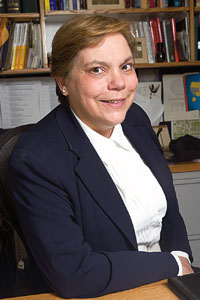Dorothy Hanck, Professor in Medicine, and the Committees on Neurobiology, Cell Physiology and Computational Neuroscience
By John EastonMedical Center Public Affairs
 Dorothy Hanck | |
While the life of the mind is revered at Chicago, “students also learn through their hands. They learn by doing things, by practicing, by talking to each other,” insists Dorothy Hanck, Professor in Medicine and a member of the Committees on Neurobiology, Cell Physiology and Computational Neuroscience. And one of the best ways to learn about a topic, she says, “is to teach someone else.”
It is comparatively easy to bring active learning to a laboratory class, Hanck says. Students in her cellular neurobiology class may be exposed to concepts like ion channels or synaptic transmission during a lecture, but the material that tends to stick with them tends to come from their time in the lab, where they have to put that knowledge to use.
“Years later,” she says, “students stop me on the Quads, and they want to talk about membrane potential or the regulation of potassium channels. That’s when I get a sense that it’s working.”
Bringing such active learning into the classroom is more of a challenge during her spring class in pharmacology, however. There is no lab. The class focuses on a small set of specific drugs and their targets. They look not just at a drug’s biochemistry or metabolism but also the process of its discovery, the economics of testing and marketing, and the social implications of drug development and use.
One example is the drug ivermectin, developed in the mid-1980s as a broad-spectrum anti-parasite medication. In the United States ivermectin is widely used to prevent heartworm in pets, but in much of the developing world, especially Africa, it is taken by humans to combat onchocerciasis, an eye and skin disease caused by a parasitic worm. The worms get transmitted to humans through the bite of a blackfly. Because these flies breed in fast-flowing rivers, the disease is known throughout the tropics as “river blindness.”
Students learn what ivermectin does and how it works, but in the process they also learn that “4.5 of the 6.8 billion people on earth are infected with parasites,” notes Hanck, “not something that most of us commonly think about.” Students also have to consider the impact on the company that makes the drug. What sort of responsibility do they have to produce and provide a drug at little or no cost? Why should they sink resources into making a drug that is taken by people in extreme poverty?
To keep students involved and “hands-on,” Hanck has the class teach, and grade, each other. They work in small groups to investigate a drug, organize the material, present it to the class and assess the other teams.
That way, “they learn the material, but they also learn life skills,” explains Hanck. The class starts at 8:30 a.m., “so they learn to function on a real-world schedule. They learn to work in groups, to organize and coordinate their schedules, to get projects done on time. They also get to practice helping each other and offering criticism.”
“You can do that with our students,” Hanck says. The University “attracts a most wonderful student,” she adds. They are “uniformly extraordinary, engaged, excited about learning. They make teaching a joy.”
Although she has never taught anywhere else, her colleagues at other universities have helped her realize how rare that can be. “They complain about teaching,” she says. “They grumble about the students. Chicago students, on the other hand, are serious. They have demanding schedules, boundless aspirations and high expectations of themselves. My job is to help them learn the material, to learn how to learn and to make it as fun as possible,” she says. “I think we are usually quite successful. I know it works for me. I love to teach. I am addicted to teaching.”
![[Chronicle]](/images/sidebar_header_oct06.gif)